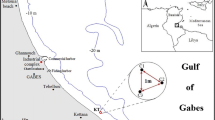Abstract
The oyster Crassostrea rhizophorae has been used as a biomonitor of trace metal contamination in two Brazilian coastal systems. C. rhizophorae were collected in January 1998 from 15 stations (from 4 coastal inlets (including 1 estuary) and 1 coastal beach) near Macau, Rio Grande do Norte (RN), Brazil, a region affected by the activities of the oil industry and salt manufacture in coastal salt ponds; oysters were also collected in September 1999 from 8 stations in the Curimatau estuary (RN), an estuary becoming increasingly affected by shrimp farming activities. C. rhizophorae is a net accumulator of trace metals and can be used as a biomonitor, the accumulated soft tissue concentrations representing integrated records of bioavailable metal over the life of the oyster. At Macau, significant differences in oyster accumulated concentrations (and hence bioavailabilities to the oyster) of Fe, Zn, Cu, and Mn were found between stations; raised zinc availabilities at the coastal site are in close proximity to oil industry activities but the very high availabilities of Fe, Cu and Mn in the Rio dos Cavalos estuary originate from an unknown source. In the Curimatau estuary, bioavailabilities of Mn, Pb and Cd, but particularly of Cu and Zn, to the oysters are raised at the two most downstream sites, the only sites below the effluent of a large shrimp farming enterprise. The oysters also act as a local food source, and concentrations of Zn, Cu and Pb of some of the oysters are above typical public health recommended limits.
Similar content being viewed by others
References
Goldberg, E. D., M. Koide, V. Hodge, A. R. Flegal & J. Martin, 1983. U. S. Mussel Watch: 1977- 1978 results on trace metals and radionuclides. Estuar. coast. shelf Sci. 16: 69- 93.
Langston, W. A., M. J. Bebianno & G. R. Burt, 1998. Metal handling strategies in molluscs. In Langston, W. J. & M. J. Bebianno (eds), Metal Metabolism in Aquatic Environments. Chapman and Hall, London: 219- 283.
Lauenstein, G. G., A. Robertson & T. P. O'Connor, 1990. Comparison of trace metal data in mussels and oysters from a mussel watch programme of the 1970s with those from a 1980s programme. Mar. Poll. Bull. 21: 440- 447.
MAFF, 1981. Survey of copper and zinc in food. Fifth Report of the Steering Group on Food Surveillance. The Working Party on the Monitoring of Foodstuffs for Heavy Metals. Food Surveillance Paper No. 5. Her Majesty's Stationery Office, London.
MAFF, 1982. Survey of lead in food. Tenth Report of the Steering Group on Food Surveillance. The Working Party on the Monitoring of Foodstuffs for Heavy Metals. Food Surveillance Paper No. 10. Her Majesty's Stationery Office, London.
Nott, J. A., 1998. Metals and marine food chains. In Langston, W. J. & M. J. Bebianno (eds), Metal Metabolism in Aquatic Environments. Chapman and Hall, London: 387- 414.
Phillips, D. J. H. & P. S. Rainbow, 1994. Biomonitoring of Trace Aquatic Contaminants (2nd edn). Chapman and Hall, London. 371 pp.
Rainbow, P. S., 1995. Biomonitoring of heavy metal availability in the marine environment. Mar. Poll. Bull. 31: 183- 192.
Rainbow, P. S., 1997. Ecophysiology of trace metal uptake in crustaceans. Estuar. coast. shelf Sci. 44: 169- 175.
Silva, C. A. R., P. S. Rainbow, B. D. Smith & Z. L. Santos, 2001. Biomonitoring of trace metal contamination in the Potengi estuary, Natal (Brazil), using the oyster Crassostrea rhizophorae, a local food source. Wat. Res. 35: 4072- 4078.
Wallner-Kersanach, M., H. Theede, U. Eversberg & S. Lobo 2000. Accumulation and elimination of trace metals in a transplantation experiment with Crassostrea rhizophorae. Arch. Environ. Contam. Toxicol. 38: 40- 45.
Wright, D. A., J. A. Mihursky & H. L. Phelps 1985. Trace metals in Chesapeake Bay oysters: intra-sample variability and its implications for biomonitoring. Mar. Environ. Res. 16: 181- 197.
Author information
Authors and Affiliations
Corresponding author
Rights and permissions
About this article
Cite this article
Silva, C.A.R., Rainbow, P.S. & Smith, B.D. Biomonitoring of trace metal contamination in mangrove-lined Brazilian coastal systems using the oyster Crassostrea rhizophorae: comparative study of regions affected by oil, salt pond and shrimp farming activities. Hydrobiologia 501, 199–206 (2003). https://doi.org/10.1023/A:1026242417427
Issue Date:
DOI: https://doi.org/10.1023/A:1026242417427




